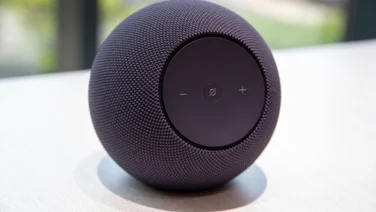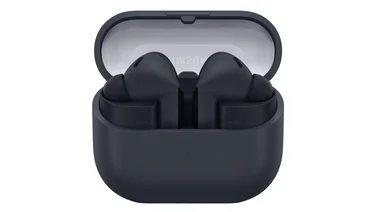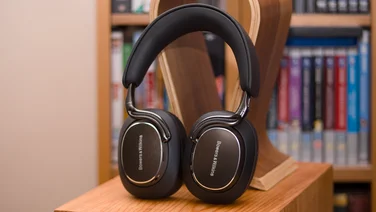To help us provide you with free impartial advice, we may earn a commission if you buy through links on our site. Learn more













- Lightweight and comfortable
- Effective, smart noise cancelling
- Fantastic sound quality
- Call quality struggles in loud environments
- No hi-res audio support for iPhone owners
The Sony WH-1000XM6 headphones have to be the most heavily leaked, highly anticipated headphones of all time. And yet, despite the furore surrounding their release, I have caught myself wondering: what’s the point in all this?
I get it, I really do. Since the WH-1000XM3, Sony’s flagship headphones have been the standard by which all other noise-cancelling headphones have been judged – and for good reason. But until we know what they sound like, how they cancel noise and how comfortable they are, I just can’t see any point in speculating.
In any event, the time for speculation is over. My testing is done, and my verdict is in: with sweeping improvements to noise cancelling, build quality, sound quality and comfort, the Sony WH-1000XM6 are the company’s finest headphones yet.
Sony WH-1000XM6 review: What you need to know
Even though it’s been three years since the last update, Sony didn’t really need to do much work on the WH-1000XM6. The most critical thing Sony’s engineers needed to fix was the easiest to resolve, and something you’d not appreciate at first: build quality. A lot of people criticised the XM5 for their fragile, plastic hinges, which were prone to breakage.
The WH-1000XM6 fix this issue by beefing up the area with metal. The hinges themselves look similar to those on the XM5, as does the exterior, but they’re clearly tougher, and it’s certainly good to see they’ve acted on what was a rare area of weakness.













Fortunately, Sony’s engineers have been busy elsewhere, too, and most significantly in upgrading the silicon that lies at the heart of everything the Sony WH-1000XM6 does. The QN3 HD is, Sony says, seven times faster than the QN1 it replaces, and that’s important because more data is coming in from more microphones than ever before. There are now even more microphones scattered around the earcups on the WH-1000XM6, up to 12 in total, both internal and external. That’s a 50% uplift from the eight microphones on the XM5.
On the sound quality front, you’re getting a new, improved 30mm driver as well, and better software-driven digital to analogue (DA) conversion courtesy of that new QN3 processor. The headphones also inherit several features from Sony’s “Signature Series” WM1ZM2 Walkman music player, and make several improvements to the user experience, including adding a 10-band custom EQ and the ability to continue listening while the headphones are charging.













Elsewhere, there’s more effective adaptive noise cancellation that can adapt to how you’re wearing the headphones, as well as where you are and what you’re doing. The ambient sound mode is better – it can now adapt to your surroundings more effectively – and Sony has made improvements to the noise and wind rejection when using the headphones on calls.
And the headphones’ charging speed has received a bump, delivering up to three hours of listening time from just three minutes of charging using a USB-PD charger. Battery life remains the same, though, at 30 hours with noise cancelling enabled.
Price and competition
It seems that Sony has left no stone unturned, no rock undisturbed in the pursuit of improvement, and you might have forgiven them for hiking up the price significantly. Fortunately, they haven’t done that. The new WH-1000XM6 cost £400, an increase of only £21 over the original price of the XM5. Of course, you can now buy the Sony WH-1000XM5 for much less than that – with the latest price cut, they’re only £250 at Amazon – and at that price, they’re a steal.
However, the WH-1000XM6 are still competitively priced versus the latest crop of noise-cancelling flagships, with most rivals costing a similar amount of money or even more.
Top of the list are the Bowers & Wilkins Px7 S3 at £399; they sound phenomenal and look incredible, but don’t cancel out noise quite as well and can’t match the Sony headphones’ customisability.













The Sonos Ace are an impressive alternative, too, with highly effective noise cancelling, innovative home theatre integration and fantastic comfort and usability, but are slightly underwhelming on the sound quality front. They’re also a little on the pricey side at £449.
Next up are the now ageing, but seemingly ever-popular Apple AirPods Max. These sound great, look a million dollars, have impressive noise cancelling and even better ambient sound passthrough – but they’re not the most comfortable and are much too expensive.
And finally, I’d be remiss not to throw in a pair from the noise-cancelling kings: the Bose QuietComfort Ultra. At £350, these are cheaper than the WH-1000XM6, come with quite superb levels of noise cancelling, but they can’t hold a candle to Sony’s best when it comes to design, features, controls and sound quality.
Design and features
To look at, the Sony WH-1000XM6 are nothing particularly special. Despite all the changes inside, the exterior is only subtly different from its predecessor: we have the same soft-touch plastic shell earcups and memory foam pads, and a similar flat surface on the outside of each of the earcups, this time circular rather than oval.
As before, the right surface doubles up as a touch control panel for adjusting the volume, skipping and play/pause controls (you can turn it off if you want) and this is complemented in the control scheme by a power/pairing button on the bottom edge of the left earcup and a noise-cancelling mode switch button right next to it, along with a 3.5mm audio jack.













As for colours, there isn’t much choice: the XM6 are available in plain white, black or Midnight Blue with nothing to offset the block of colour save the subtle silver Sony logo on the outer surface of the hinges and the faint L and R indicators on the inside of the hinges. Alas, the dusky pink that was introduced later in the XM5’s lifecycle hasn’t made the cut just yet.
The general shape is a little more organic than its predecessor, the overall look somewhat chunkier, and the headband slightly squared off, presumably to accommodate a wider array of head shapes. Some might take offence at the blockier look, I suppose, which in silhouette looks disturbingly stormtrooper-esque, but it doesn’t bother me at all. Then again, I never have been one to concern myself with appearances.
Look closely and you’ll be able to discern more subtle changes. The headband is now wider and shaped asymmetrically, with a slight bulge towards the rear – Sony’s designers say this is to help you tell intuitively which way to put the headphones on, without having to look at the interior hinges for the L or R labels, although Sony could have made that easier simply by stencilling larger L and R lettering on the inside of the earcup mesh fabric, like most other manufacturers do.













And the hinges themselves have been designed to be less ”swingy”; essentially, increased tension in the joint between headband and earcup means they feel less loose when you pick them up.
That’s a nice improvement, but perhaps more important is that the WH-1000XM6 can now be folded up flat or in on themselves to make an even more compact package; the XM5 didn’t fold up at all. That’s great news, not only because the case can now be smaller, but also because you can now fold the earcups flat against your collarbone when you’ve got the headphones around your neck. For travelling, that’s an absolute godsend, and it means these headphones are just as comfortable to wear, whether you have them clamped on your ears or not.
Speaking of which, the headphones are incredibly comfortable when you are listening to them. I found them a touch on the on the warm side, but in terms of the pressure they exert they’re just about perfect for me – they feel a little lighter on the head than the Bowers & Wilkins Px7, but apply enough pressure that they don’t feel like they’re going to fly off when you sneeze or bend down to tie your shoelaces. They weigh only 253g (3g more than the XM5), plus the memory foam in the earcups and vegan leather covering is soft enough that the noise cancelling isn’t compromised when you move your head around. Even wearing glasses didn’t affect comfort levels or noise cancelling unduly.
Sony has long held a solid lead in this area, not necessarily for its ability to outright deaden external ambient noise, but because it combines superb ANC with a huge number of quality-of-life functions that help you make the most of the hardware.

And here, Sony has made some changes that tweakers will appreciate. First on the list is an increase in the number of bands usable for the custom EQ from five to ten, with sliders at 31Hz, 63Hz, 125Hz, 250Hz, 500Hz, 1kHz, 2kHz, 4kHz, 8kHz and 16kHz – via the Sony Sound Connect app. You can create and store up to three EQs of your own and choose from several Sony-created presets.
As before, the headphones can detect your location and whether you are walking, stationary or running – and can adjust noise-cancelling levels and how much ambient sound is mixed in on the fly. New this time around, though, is something Sony is calling Scene-based listening. Using this feature, you can customise what the headphones do in different scenarios. For example, you can set them up so that they instantly resume what you were last listening to on Amazon Music when you put them on for a run, and Spotify when you put them on while walking, plus you can refine that by location and time.
I can’t see myself using this much, partly because it seems like a feature in search of a purpose, but also because the list of audio apps you can choose from to play automatically is limited. You can choose from Amazon Music, Spotify, Apple Music, YouTube Music and Endel, but not Audible or any podcast app.

Noise cancelling, ambient aware and call quality
Sony has upped its game considerably with the introduction of the WH-1000XM6, not that it really needed to. The WH-1000XM5 remain among the most effective noise-cancelling headphones around, three years after their release. Still, Sony is convinced these new ones needed to be better and, to that end, has increased the number of microphones by 50% to 12, with four external and two internal microphones in each earcup.
I don’t have a pair of XM5 to compare the XM6 directly with, but I can say that they are better than the two pairs I did have on hand for testing – the Bowers & Wilkins Px7 S3 and the Sonos Ace. No ANC headphones are going to get rid of all ambient sound, but the XM6 did a good job of killing the most annoying audio across the frequency spectrum, from the continuous low roar of aircraft cabin noise to the high-frequency tapping of computer keyboards in an office environment and the rush of road noise.













In back-to-back comparisons, all three headphones performed well, cutting out a lot of ambient audio. But the Sony headphones just about held the edge on the Sonos Ace, seeming to cut out a fraction more across the frequency spectrum, while both stride ahead of the Px7 S3 by some margin.
The Sony’s ambient aware features are also superior. Not only do the WH-1000XM6 pass through audio from the external microphones in a more natural manner, but they also give you more options as to how you activate the mode. As with most ANC headphones, you can use a button to toggle between ambient aware and noise cancelling modes – on the Sonys, this is situated on the left earcup – and using this simply disables ANC, piping in some external audio so you can listen out for railway station announcements, or hear approaching vehicles while crossing the road.
Hold your hand over the touch surface on the right earcup, and the headphones instantly mute the music and disable ANC, allowing you to talk to and hear what someone is saying without having to remove the headphones from your ears. Finally, there’s also the option to enable a Speak-to-Chat mode, which does the same whenever the headphones detect you’re speaking; although beware, if you’re in the habit of humming or even singing quietly along to your music, you might activate this by accident.













Finally, Sony says it has improved call quality, mainly thanks to the extra external microphones, which use beamforming tech to filter out ambient noise. I tested this out by playing aircraft noise through some speakers at various volume levels in my kitchen to see how it would affect call quality, and I had mixed results.
The headphones do a remarkably good job of killing ambient sound off completely, even with the volume turned right up to uncomfortable levels, but the quality of voice pickup is variable. It’s fine when the ambient noise isn’t too loud (up to around 77dBA), but it suffered bad distortion and compression if ambient noise rose to levels much higher than that, and it was really quite bad at around 87dBA. On the Sonos Ace, my voice was far easier to hear at these levels, although they didn’t kill off the background noise quite as effectively. This is the one area Sony could do with making some improvements, perhaps by not being quite as aggressive with the noise-cancelling settings.
Sound quality
I’ve listened to a lot of headphones throughout my career, particularly those around the £350 to £400 mark, and I’ve rarely been disappointed. For this sort of money, you’ll rarely find yourself short-changed these days; headphones may sound different to one another in terms of balance and tuning, but I don’t think I’ve come across a pair I don’t like.
These latest Sony headphones certainly don’t disappoint on this front. In terms of audio codecs, they support SBC, AAC and, only for Android phone owners, Sony’s LDAC. That means iPhone owners miss out on Hi-Res audio, which AAC doesn’t support. If this is important to you, pick up a pair of Bowers & Wilkins Px7 S3, which can receive hi-res audio via USB-C.
Having said that, even listening to AAC and SBC content, the Sony WH-1000XM6 are sonically highly accomplished, and Sony has been hard at work improving them. The 30mm millimetre carbon composite drives have been upgraded – the dome is now stiffer and the surround softer than before – and the QN3 processor comes with more technologically accomplished DA conversion software that uses something Sony calls a “look-ahead noise shaper” to deliver what the press release says allows the WH-1000XM6 to “predict and optimize quantization noise while responding quickly to sudden sound changes.” This, Sony says, provides clearer details and richer bass.













For this part of my testing, I chose to compare the WH-1000XM6 back-to-back with the Bowers & Wilkins Px7 S3, which are the best over-ear noise cancellers for sound quality I’ve ever clapped ears on. And while the WH-1000XM6 can’t quite match the Bowers for dynamism and sheer muscularity, they are a highly enjoyable listen. They’re a little more laid back, perhaps, but still provide oodles of detail and clarity, deliver richness in the mid tones and a deep yet detailed bassline that made me want to get up from my desk and start dancing around the office.
To kick off, I started with a trawl through my usual playlist, which is stuffed with tracks from all different kinds of genres, from quiet jazz to raucous metal and everything in-between – and the Sony WH-1000XM6 took every one in its stride. Starting with something nice and easy, I fired up Kraftwerk’s The Robots and was regaled with huge dollops of juicy, well-controlled bass and plenty of pleasing, crisp, sharp-edged detail. Compared with the Px7, there’s a touch less space between the parts, and the music doesn’t sound quite so clean and controlled, but that doesn’t detract from the enjoyment at all.













Moving on to Melody Gardot’s My One And Only Thrill, and it’s the same picture. The Sony WH-1000XM6 are superb, reproducing the singer’s mellifluous vocals with a sense of richness that will have you singing along (in my case badly), while picking out the rest of the instruments in the band in such a beautifully balanced way that I went back and listened to them all over again. Again, there’s less sense of space and depth than you get with the Px7 S3, but this is like comparing a bottle of Veuve Clicquot Yellow Label with a Piper-Heidsieck Cuvee Brut – both are very, very delicious, it’s just that one is that little bit better.
The XM6’s bombastic bass reproduction really works with music such as Kiasmos’ Burst, a splurge of electronic joy, but less so with more complex, multi-layered guitar rock like Six By Seven’s Eat Junk Become Junk. Having said that, I had no complaints about the WH-1000XM6’s rendition of Mozart’s Requiem, Lacrimosa, delivering its dramatic crescendo of voices with real panache, atmosphere and emotion.
Before I go any further, there are a couple of extra features that are worth noting: 360 Reality Audio Upmix for Cinema, which takes a stereo signal and turns it into a virtual surround sound mix; and DSEE Extreme, which takes low-bitrate MP3 audio and upscales it. I’m not usually a big fan of virtualised sound processing, especially of the surround sound variety, as it usually compromises sound quality to achieve the effect. Here, it is no different; and while enabling the effect certainly adds an extra bit of pizzazz to movie soundtracks, the overall effect is that the audio takes on a slightly harsh, tiring edge at the same time.
Sony WH-1000XM6 review: Verdict
Overall, though, it’s difficult to dislike the Sony WH-1000XM6. Sony has taken note and given us back a pair of neatly folding headphones that are supremely comfortable to wear, and it has delivered exceptional noise cancellation technology and sound quality once again.
These are not the perfect headphones. Call quality is lacking in loud environments, and the Bowers & Wilkins Px7 S3 deliver superior sound quality. But when it comes to the all-round package, the Sony WH-1000XM6 just edge out their competitors, combining superior customisability, usability and comfort, with top-level noise cancellation and sensational sonic performance. They will likely sit atop our best headphones listings for some time to come.







